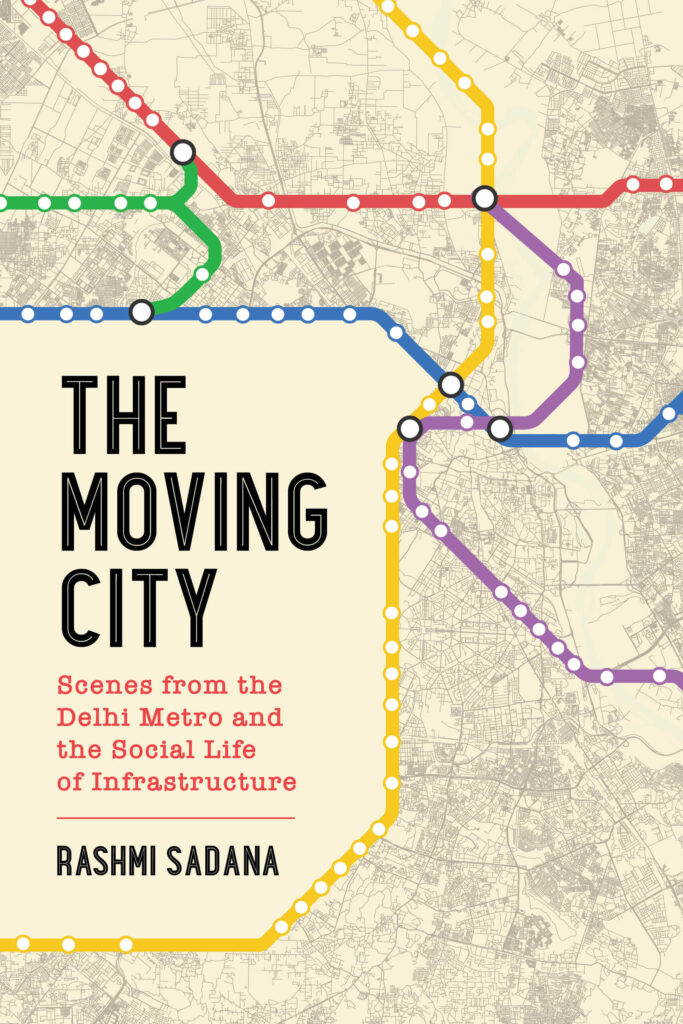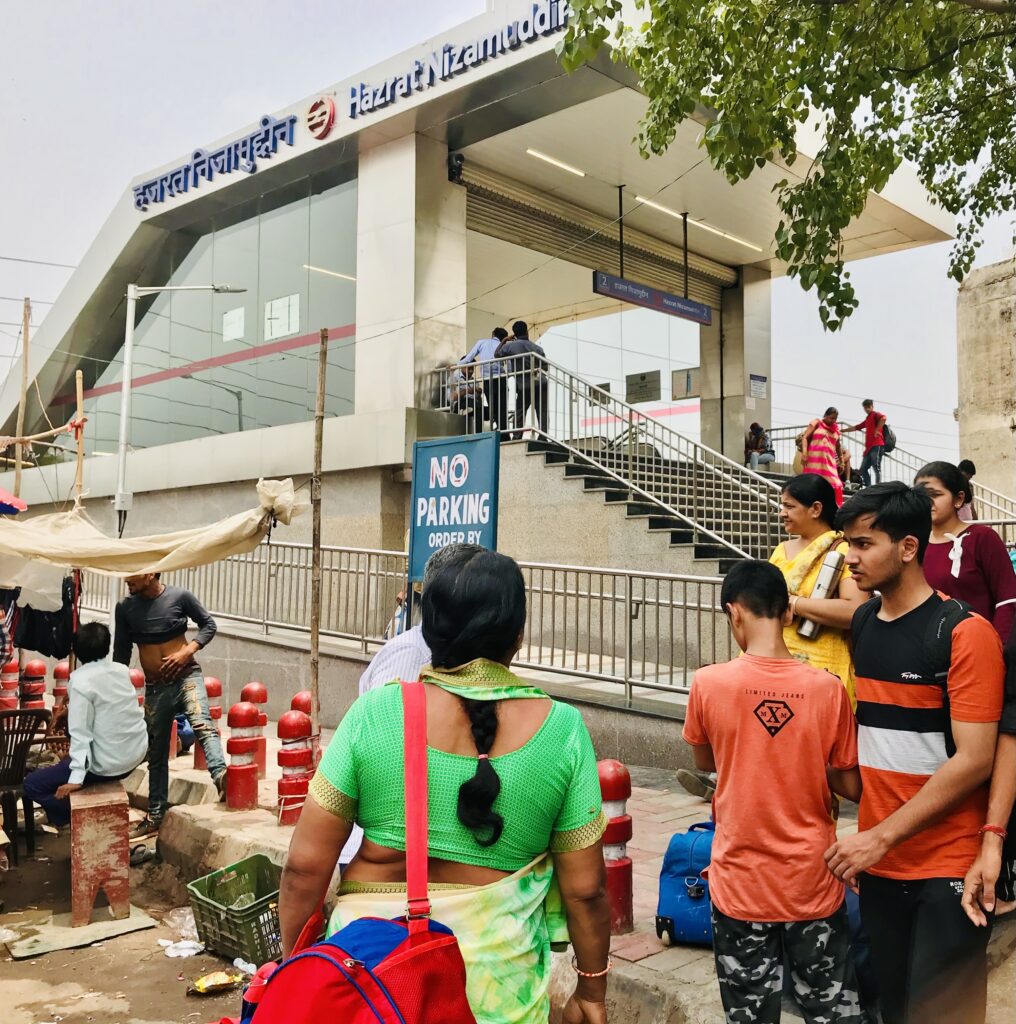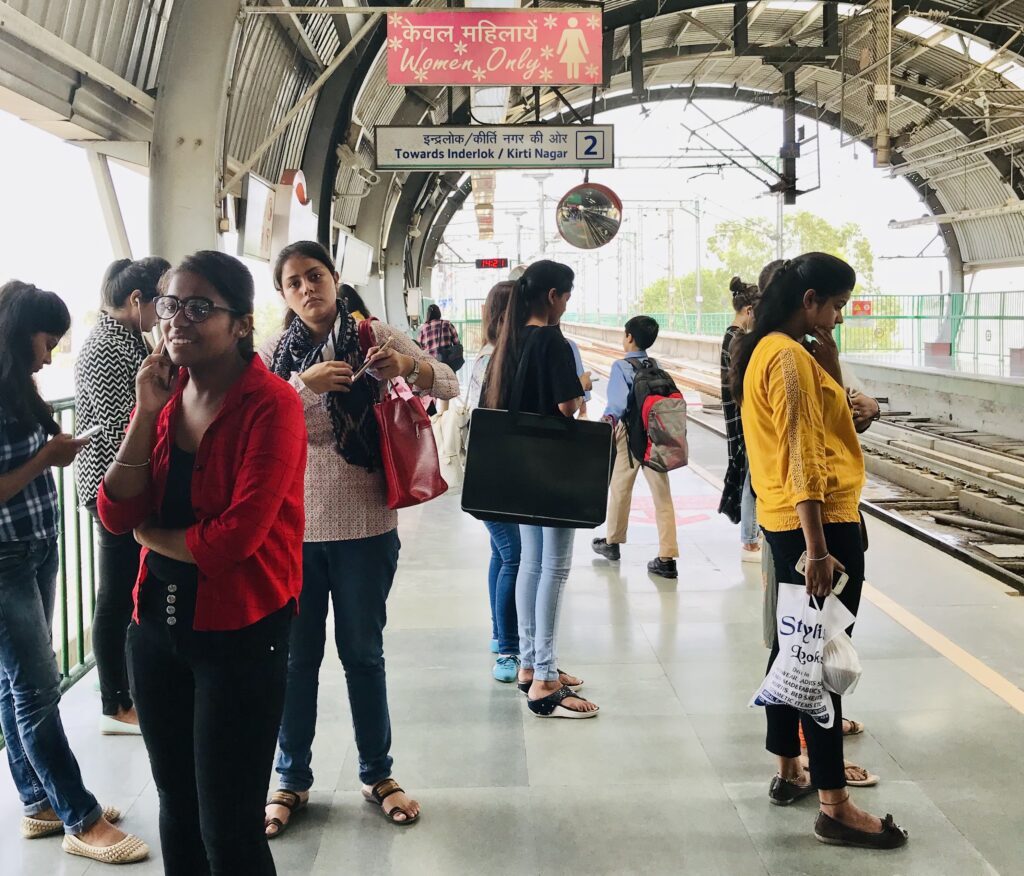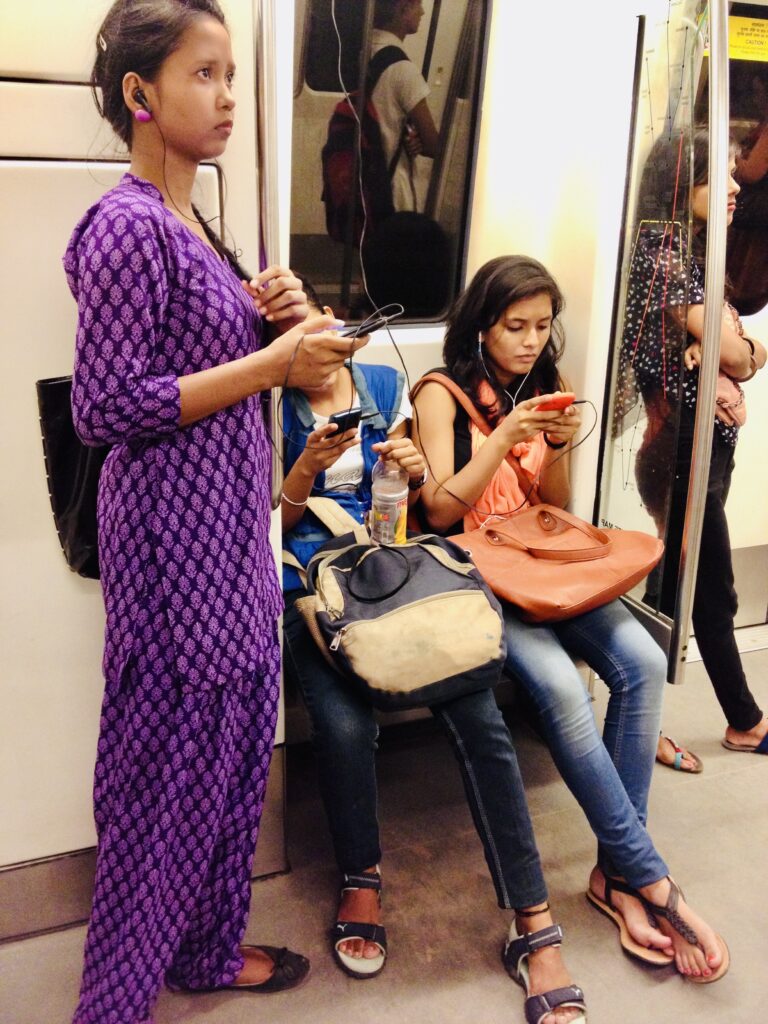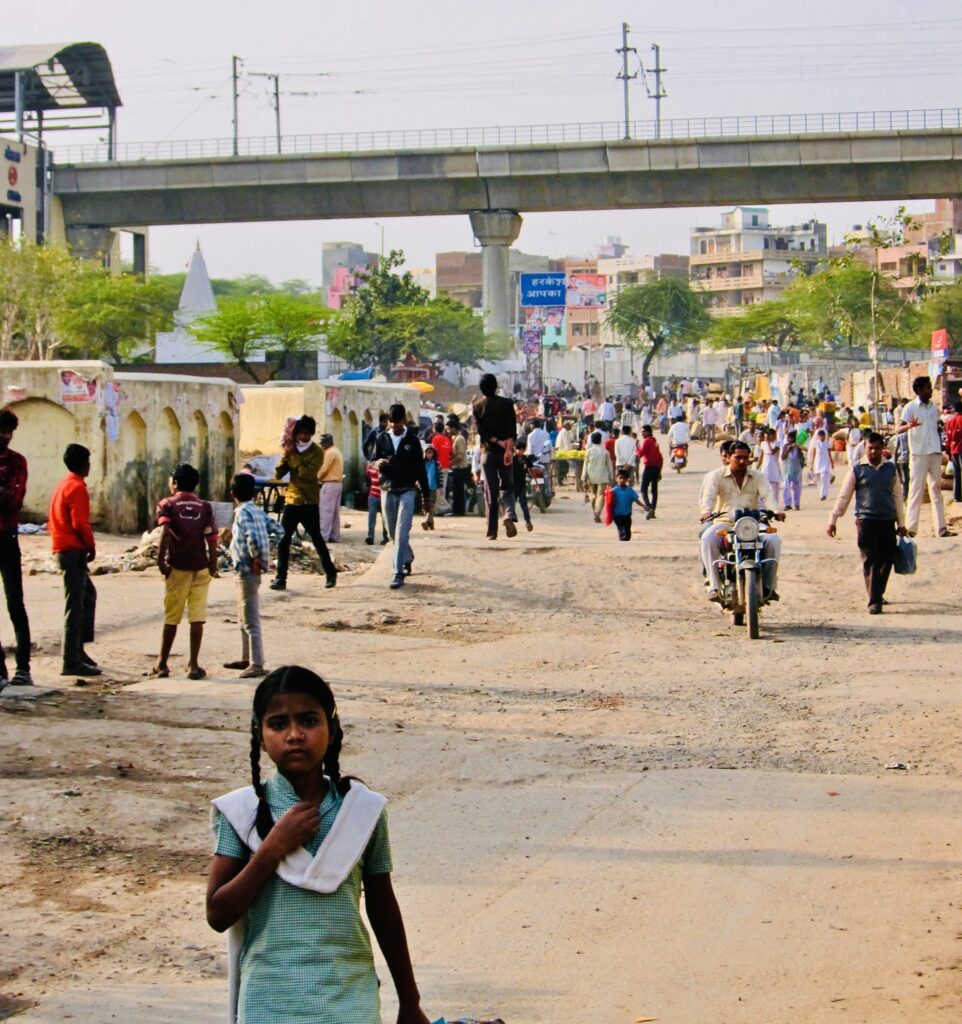In Delhi, Women Find Their Place on the Metro
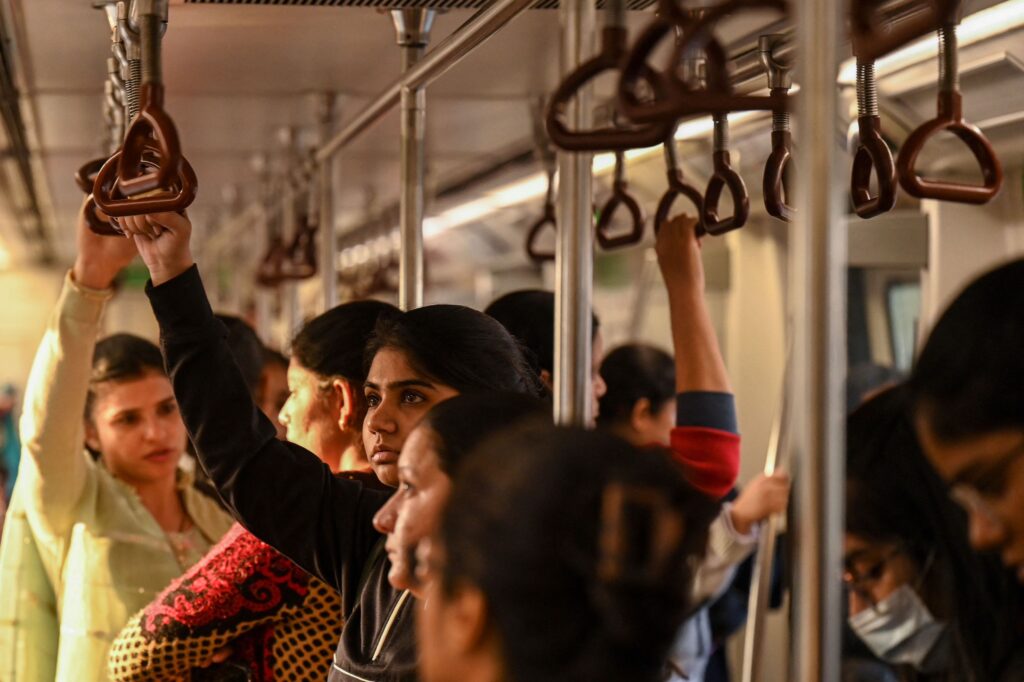
Excerpted from The Moving City: Scenes From the Delhi Metro and the Social Life of Infrastructure by Rashmi Sadana. University of California Press, 2022. All rights reserved.
The Moving City tells the story of how a state-of-the-art, multiline subway system gets integrated into a densely developed megacity such as Delhi. [1] [1] This book was also published by Roli Books in South Asia as Metronama: Scenes From the Delhi Metro. As of 2022, which marks the 20-year anniversary of the Delhi Metro, the metropolitan area of India’s capital city held a population of more than 32 million people, making it the second-largest metropolitan population in the world.
As an urban anthropologist, I rode the Delhi Metro and talked to hundreds of people over 10 years so I could recount the social impact of the system from the ground up. During that time, the subway expanded from three lines to nine to serve the geographic reaches of this sprawling city-region. Delhi is often portrayed either as a rich city of powerful bureaucrats and politicians or as a poor city of slum dwellers. The Moving City looks at the in-between sectors—the burgeoning global working and middle classes—and reveals their aspirations and itineraries on the trains and in life. The book’s form, composed of 75 brief scenes or micro-ethnographic encounters, came to mimic the stops and starts of the trains.
A key theme of the book is “visibility”—that is, how the Metro makes visible social realities and divisions that were previously hidden or ignored. As the three excerpts below show, many women, in particular, see the Metro as a game-changer in a city that has been especially dangerous for them to navigate. In 2012, a woman named Jyoti Singh was gang raped and murdered while riding a private bus. She had been unable to find other forms of transport to get home after seeing a movie with a friend at a south Delhi cineplex. More recently, Delhiites have been protesting the horrific hit-and-run death of Anjali Singh, who was killed on January 1 when her scooter was hit by a car and her body dragged for an hour.
The Metro, by contrast, promises a different transport experience: women-only coaches and controlled, monitored stations that offer a sense of safety. Still, as a public space meant to be accessible to all, the Metro doesn’t always live up to its promises of being a social equalizer across class, caste, religion, ethnicity, race, and ability. It doesn’t go everywhere and is not affordable for everyone in comparison to buses, for instance. But as a social stage, the Metro is reshaping existing power dynamics across lines of difference—especially gender and class—and offering new ways for people to belong to and get around the city.
RAVEENA
When you get off at the elevated Mundka station on the Green Line, a line of small white vans waits for passengers at the bottom of the escalator. Young male drivers call out placenames for destinations across Haryana, a state known for agriculture and industrial production that borders Delhi. Cow dung patties dry in the sun to one side of the station escalator; jagged lines of cars and buses jostle on the other. Half-built Metro stanchions leading to future stations rise in the distance.
Leaving Mundka, Raveena, a slim woman in her 20s, gets on the women-only coach of the Metro. [2] [2] All names of interviewees have been changed to protect people’s privacy. We start to chat, and she tells me that her father drops her off and picks her up at the station each day. She takes the Metro a few stops eastward to Paschim Vihar to attend college. She is certain that she would not be on the Metro at all if it were not for “the ladies’ coach.”
“After Mundka, it’s good,” she says, “but before Mundka, it’s very bad, the crowd and all.” For Raveena, “crowd” is about place, about where you are from and the attitudes you may hold.
“Haryana is not good, not good for girls. Men are not good, even boys. They stare at me, sometimes they vent at me. I can’t do anything,” she explains. “Vent” is typical Delhi-speak to describe when someone lashes out in a stream of verbal abuse, erupting like a volcano. On the street, they see her as a species rather than a person. What are they angry about? That she is a girl in public, that she moves with confidence, that she is protected, that she studies, that they don’t have girlfriends, that they don’t have jobs, that, ironically enough, there aren’t more women around.
On the Metro, the crowd is simply more “neutral,” Raveena says, and I also see that it allows her to imagine, and perhaps enact, a future beyond it.
Delhi has been notorious as a place where women not only get harassed on the street but also may be subjected to the grisliest of crimes. These stories and statistics feed into a larger narrative about girls’ and women’s safety and their proper place in the city (usually at home). The safety discourse teaches women from a young age that it is their fault if anything happens to them and that they need male protectors and guardians to get through life—and public spaces. And yet on the streets and lanes of Delhi, you see women everywhere; they have places to go and things to do, from moving bricks at construction sites to leading the city as top-ranking public officials.
As state-sponsored infrastructure, the Delhi Metro has given women, in particular, a new way into the city, as a site of purpose, aspiration, and pleasure.
YELLOW LINE
On the Yellow Line, a woman sits nursing an infant not more than 20 days old. We are not in a ladies’ coach but in a mixed one where, on this morning, the ratio of men to women is about 20-to-1. A glass panel with a map of the Metro system is all that separates me from the woman. I can tell she is not poor but also not well off. She has dark, chipped nail polish on her toes and wears a nondescript sari with a frayed, light sweater. It’s summer, and it’s cold inside the air-conditioned train. She looks like a first-time mother to me, awkward in her feeding technique; she has the baby wrapped in a blanket on her lap.
I feel protective toward her but keep quiet and start to make up a story in my head to explain why she is taking the Metro. I glance around to make sure no one is looking at her, and yet I also don’t want to invade her privacy, even as a well-wisher or a would-be protector. There are two men who seem to be with her, but they are stern and silent, and I find this off-putting, maybe even a little distressing. Then my stop comes, and I get off.
Later, in the ladies’ coach on the Yellow Line, I strike up a conversation with two young women. Manasi tells me, “There are so many girls working, we need more women’s coaches. If I’m a girl wearing a short dress, I might not prefer the general coach. I don’t know what kind of person I’ll meet in that coach.” Her friend Ekta, who, like Manasi, is in her 20s, thinks of herself as a child of the Metro generation. “People in buses are more friendly,” she says, “there’s more adventure. In the Metro, it’s boring, sophisticated, but not friendly. There’s no color, you can say.” I wonder if she means that her generation shares more qualities with the Metro as she describes it, but before I can ask her, she and Manasi are off the train.
Rajiv Chowk station, the largest station in the system, is jampacked on the platforms. The flow of people at this central interchange beneath Connaught Place is akin to a tidal wave. You have to move with the wave in the direction it is going and hope that is where you want to go. It is a festival (a mela in Hindi) of movement. I step aside where there is a large sign hanging from a low railing that no one seems to notice, about escalators and elevators and how to use them. Families pass by carrying big plastic blanket bags filled with household items. Three middle-aged men wrapped in beige shawls and bright yellow turbans follow them. Dozens of young women and men in their 20s, wearing jeans and Converse-like sneakers, all sport earbuds and are glancing at their phones, rarely talking on them. One young woman wearing a short top and green leggings with tan ankle boots asks me how to get to Malviya Nagar, an upscale residential area. “Take the Yellow Line toward Huda City Centre,” I tell her.
At the northern end of the Yellow Line, a dusty path traverses block after block of low-income housing. I walk for an hour and see nothing resembling central Delhi. This is a working-class community that all of a sudden feels included in the city, connected to this gleaming train. Women living in this neighborhood have stated that they feel safe to venture on the Metro alone, and for the first time will go to India Gate without their husbands. And as I sit outside the station one afternoon, I see these women coming and going, with suitcases and parcels, or just with one another. Some of them use the ends of their saris to cover their heads.
A cycle rickshaw-wala outside the station tells me that now most of his trips involve ferrying people to and from the Metro. It has been good for his business, though he has yet to ride it himself. “Where would I leave my rickshaw?” he asks.
THE PHOTO THAT WENT VIRAL
Four women are in the frame, from left to right: a young woman in a pink sweater and jeans sits looking down at the floor, a mother in a purple salwar kameez suit (a long tunic and pants) and gray cardigan sits next to her toddler, another young woman in black jeans and a sweatshirt hunches over a blue backpack while looking at her smartphone, and adjacent to the bank of seats, another woman sits cross-legged on the floor, wearing a salwar kameez suit and a pink shawl. She’s clutching a diaper bag. The woman sitting on the floor, who will come to be identified as “the nanny,” is looking off into space, although she is also on the edge of the photo frame, so it is unclear if her gaze is fixed on something.
This ordinary scene photographed in the ladies’ coach of the Delhi Metro was tweeted by a journalist who happened to be riding the train one day. The journalist’s tweet stated, “Seen in Delhi metro: Mother and child take seats while the child’s nanny sits on the floor on a fairly empty train. Caste/class discrimination really is space-agnostic.”
To sit on the floor is to recall caste distinctions common in Delhi between upper castes, who sit on raised surfaces, and those who sit on the ground. Within hours, the photo and caption generated thousands of likes, retweets, and comments. The comments ranged from those thanking the journalist for having exposed such persistent social hierarchies to those lambasting her for spewing trash and untruths that made India look bad.
The photo went viral when it crossed multiple social media platforms, including Instagram and Facebook, and became the subject of numerous online news articles, opinion pieces, and blog posts. For a moment, it seemed all eyes were trained on these women and their seating arrangements. Shekhar Gupta, the editor-in-chief of the online news portal The Print, wrote in praise of the journalist’s tweet (who he calls “our reporter”) and proclaimed that “class is the new caste.”
It’s not always easy to tell how people are socially related on the Metro. In this case, the journalist said she had asked the nanny why she was sitting on the floor. Not surprisingly, the nanny said it was her choice to do so.
The journalist’s commentary on the photo was refuted by the mother, who turned out to be a doctor at the All India Institute of Medical Sciences, the country’s premier medical research unit and government hospital known for serving the poor. The mother-doctor says, by way of an open letter on her brother’s blog then reported in Outlook Magazine, that they were all sitting on the floor, and she had just gotten up to appease her child and then ended up sitting on the empty seat to feed him. She goes on to detail the supportive relationship she has with her nanny and how well she treats her.
Regardless, the image struck a chord and came to represent a contrast: the open, liberal, and equalizing space of a Metro train versus the long-standing hierarchical relationship between employer and servant, an embodied relationship that is ubiquitous in the city.
Not only in the photo itself, but in a larger sense, the Metro has become a frame for looking more closely at such tensions in Indian society. The space of the coach is meant to be a social equalizer: There is only one kind of seat or space to stand or sit and one class of ticket. The viral photo bruises liberal sensibilities and says that the Metro is a container for and conduit of persistent hierarchies of caste and class.
In a different kind of response to the photo, a trade union organizer in Chennai made a policy plea for the government to recognize domestic workers legally. This legal recognition would ensure them contracts and minimum wages, but also place others in a better position to detect and prosecute cases of abuse and trafficking. In an article in The Print, she asks readers to consider calling for legislative change if they were so bothered by the class dynamics exposed in the photo, to engage beyond their “momentary interest.” It is the lack of public recognition that makes these workers not only vulnerable but, she says, “mostly invisible.”
The Metro, as public transport, is also a moving picture of social relationships, sometimes laid bare. In this case, a photo taken in the Metro—and shared across digital platforms—sparked debate on issues that on the surface had nothing to do with transport. Yet two mobilities, two kinds of movement were for an instant juxtaposed and captured on film. And with it, the great anxiety that exists about who is moving up in the world and who is staying in place.
This excerpt has been edited for style, clarity, and length.
































